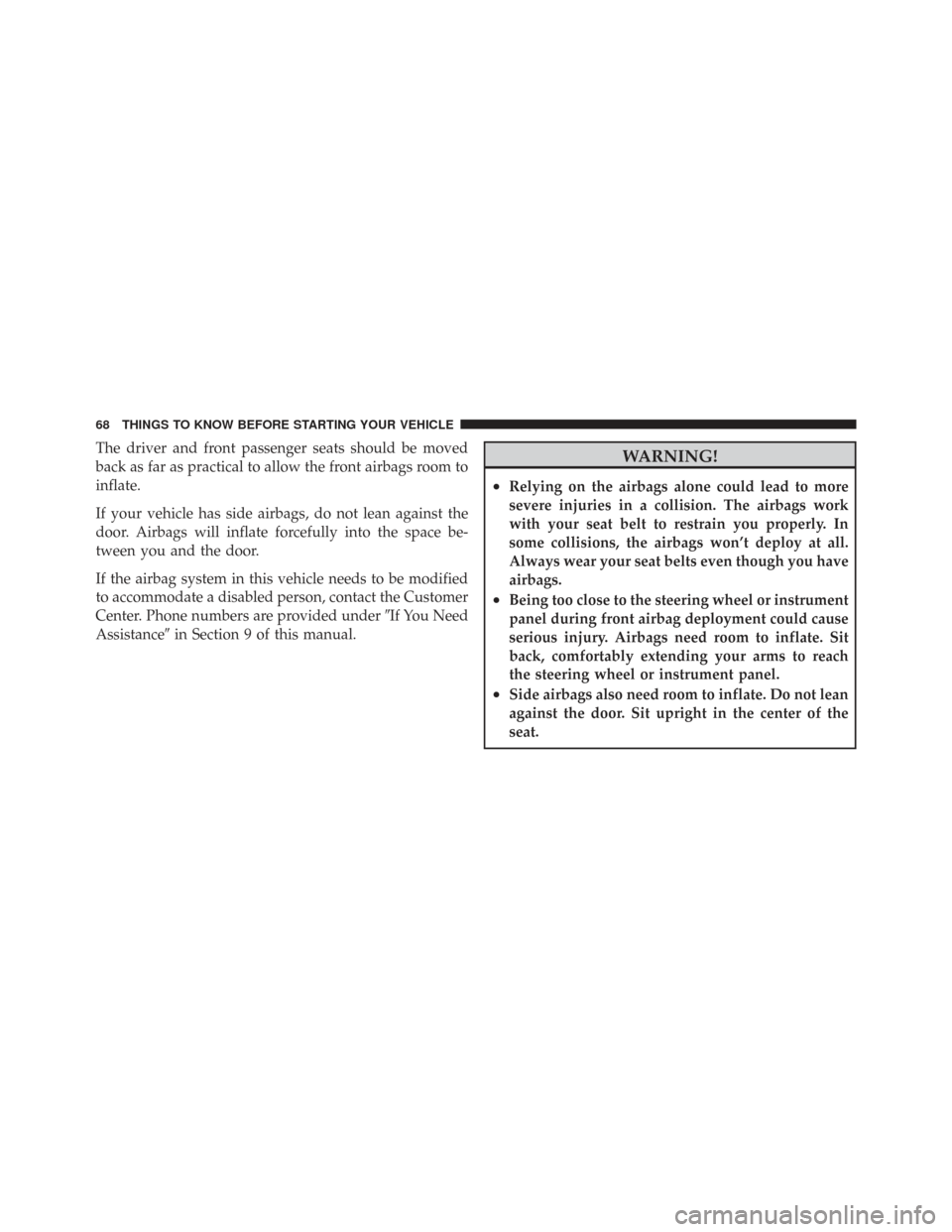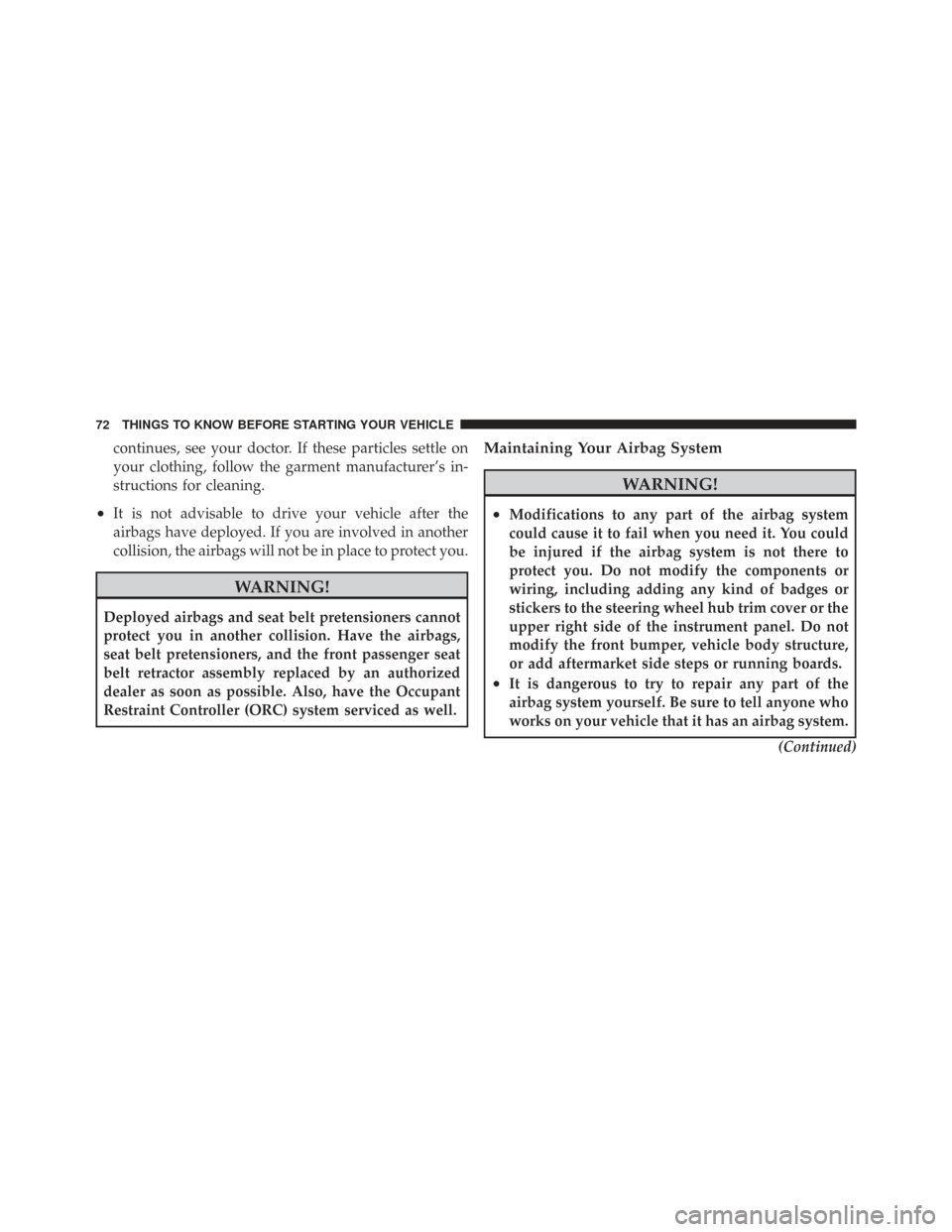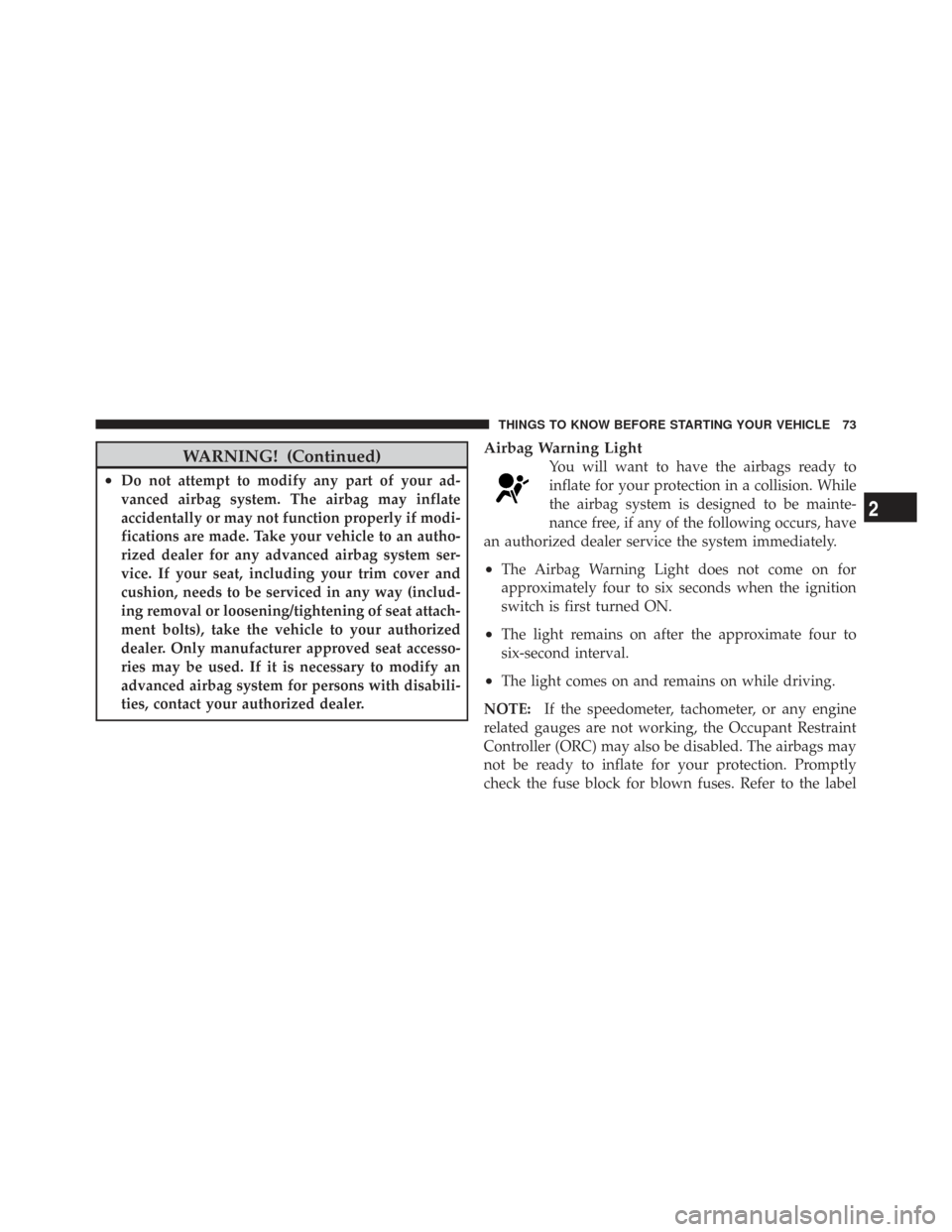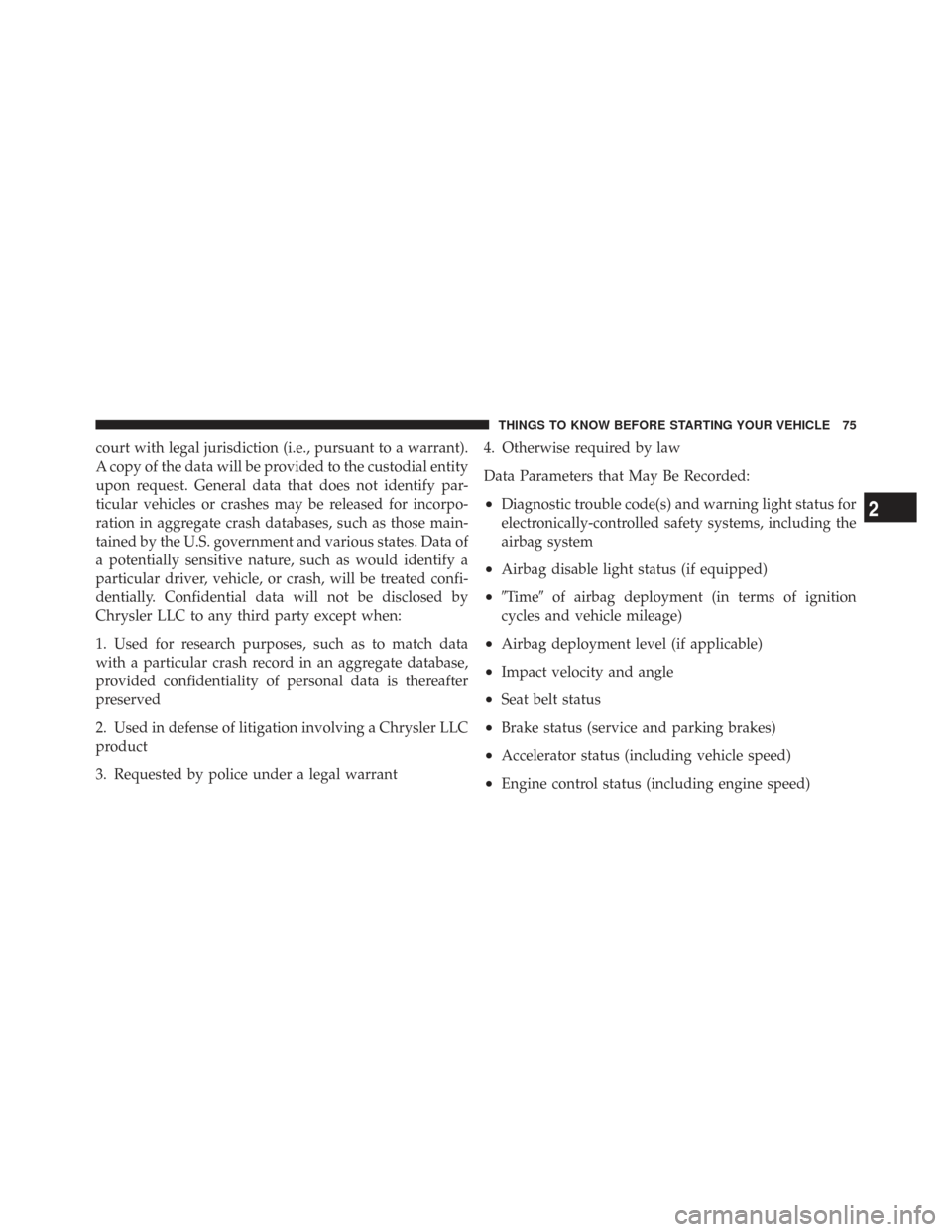Page 67 of 543

driver, front, and rear passengers sitting next to a win-
dow. If the vehicle is equipped with SABIC airbags, they
are located above the side windows and their covers are
also labeled: SRS AIRBAG.
NOTE:Airbag covers may not be obvious in the interior
trim; but they will open to allow airbag deployment.
Airbag System Components
The airbag system consists of the following:
•Occupant Restraint Controller (ORC)
•Airbag Warning Light
•Driver Airbag
•Front Passenger Airbag
•Front and Side Impact Sensors
•Steering Wheel and Column
•Instrument Panel
•Seat Belt Reminder Light
•Knee Impact Bolster
•Front Seat Belt Pretensioners
•Supplemental Side Airbag Inflatable Curtains (SABIC)
(if equipped)
Front Airbag Features
The front airbag system has dual-stage driver and front
passenger airbags. This system provides output appro-
priate to the level of crash severity as determined by the
Occupant Restraint Controller (ORC) and the impact
sensors at the front of the car.
The first stage inflator is triggered immediately during an
impact that requires airbag deployment. The timing of
the second stage determines whether the output force is
low, medium, or high. If a low output is sufficient to meet
the need, the second stage is expended later in the crash
event.
2
THINGS TO KNOW BEFORE STARTING YOUR VEHICLE 65
Page 68 of 543

In addition to the small size, the inflating gases exit
through strategically placed vents, which direct the gas
away from the occupant.
Supplemental Side Airbag Inflatable Curtain
(SABIC) — If Equipped
SABIC Airbags offer side-impact and vehicle rollover
protection to front and rear seat outboard occupants in
addition to that provided by the body structure. Each
airbag features inflated chambers placed adjacent to the
head of each outboard occupant that reduce the potential
for side-impact head injuries. The curtains deploy down-
ward, covering both windows on the impact side.
NOTE:
•Should a vehicle rollover occur, the pretensioners
and/or SABIC curtains on both sides of the vehicle are
deployed.
•Airbag covers may not be obvious in the interior trim;
but they will open to allow airbag deployment.The system includes sensors adjacent to both front and
rear seat occupants that are calibrated to deploy during
an impact severe enough to require airbag occupant
protection.
WARNING!
If your vehicle is equipped with left and right Side
Airbag Inflatable Curtain (SABIC), do not stack
luggage or other cargo up high enough to block the
location of the SABIC. The area where the side
curtain airbag is located should remain free from any
obstructions.
Airbags inflate in moderate to high speed impacts. Along
with seat belts and pretensioners, front airbags work with
the knee bolsters to provide improved protection for the
driver and front passenger. Side airbags also work with
seat belts to improve occupant protection.
66 THINGS TO KNOW BEFORE STARTING YOUR VEHICLE
Page 70 of 543

The driver and front passenger seats should be moved
back as far as practical to allow the front airbags room to
inflate.
If your vehicle has side airbags, do not lean against the
door. Airbags will inflate forcefully into the space be-
tween you and the door.
If the airbag system in this vehicle needs to be modified
to accommodate a disabled person, contact the Customer
Center. Phone numbers are provided under�If You Need
Assistance� in Section 9 of this manual.WARNING!
•Relying on the airbags alone could lead to more
severe injuries in a collision. The airbags work
with your seat belt to restrain you properly. In
some collisions, the airbags won’t deploy at all.
Always wear your seat belts even though you have
airbags.
•Being too close to the steering wheel or instrument
panel during front airbag deployment could cause
serious injury. Airbags need room to inflate. Sit
back, comfortably extending your arms to reach
the steering wheel or instrument panel.
•Side airbags also need room to inflate. Do not lean
against the door. Sit upright in the center of the
seat.
68 THINGS TO KNOW BEFORE STARTING YOUR VEHICLE
Page 71 of 543

Airbag Deployment Sensors and Controls
Occupant Restraint Controller (ORC)
TheORC is part of a Federally regulated safety system
required for this vehicle.
The ORC determines if a frontal or side collision is severe
enough to require the airbags to inflate. Based on the
impact sensors signals, a central electronic ORC deploys
the front airbags, side airbag inflatable curtains, and front
seat belt pretensioners as required for each type of
impact.
The ORC monitors the readiness of the electronic parts of
the system whenever the ignition switch is in the START
or ON position. If the key is in the LOCK position, in the
ACC position, or not in the ignition, the airbags are not
on and will not inflate. The ORC contains a backup power supply system that
may deploy the airbags even if the battery loses power or
it becomes disconnected prior to deployment.
Also, the ORC turns on the Airbag Warning
Light in the instrument panel for approxi-
mately four to six seconds for a self-check
when the ignition is first turned on. After the
self-check, the Airbag Warning Light will turn off. If the
ORC detects a malfunction in any part of the system, it
turns on the Airbag Warning Light, either momentarily
or continuously. A single chime will sound if the light
comes on again after initial startup.
It also includes diagnostics that will illuminate the instru-
ment cluster Airbag Warning Light if a malfunction is
noted. The diagnostics also record the nature of the
malfunction.
2
THINGS TO KNOW BEFORE STARTING YOUR VEHICLE 69
Page 72 of 543

WARNING!
Ignoring the Airbag Warning Light in your instru-
ment panel could mean you won’t have the airbags to
protect you in a collision. If the light does not come
on, stays on after you start the vehicle, or if it comes
on as you drive, have the airbag system checked right
away.
Front and Side Impact Sensors
Impact Sensors trigger airbag deployment in front and
side impacts, and aid the ORC in determining appropri-
ate response to impact events. Additional sensors in the
ORC determine the level of airbag deployment and
provide verification.
Supplemental Side Airbag Inflatable Curtain
(SABIC) — If Equipped
The ORC deploys the SABIC during a collision with
other vehicles and during collisions where the impact isconfined to a particular area of the vehicle. In these
events, the ORC will deploy the SABIC only on the
impact side of the vehicle.
NOTE:
The ORC will also detect and protect for rollover
events. In a rollover the pretensioners and/or SABIC
airbags will deploy on both sides of the vehicle.
Enhanced Accident Response System
In the event of an impact causing airbag deployment, the
vehicle communication network intact, and the power
intact, the ORC will determine if the event is severe
enough for the Enhanced Accident Response System to
perform the following functions:
•Cuts off fuel to the engine.
•Flashes hazard lights as long as the battery has power
or until the ignition key is turned off.
70 THINGS TO KNOW BEFORE STARTING YOUR VEHICLE
Page 74 of 543

continues, see your doctor. If these particles settle on
your clothing, follow the garment manufacturer’s in-
structions for cleaning.
•It is not advisable to drive your vehicle after the
airbags have deployed. If you are involved in another
collision, the airbags will not be in place to protect you.
WARNING!
Deployed airbags and seat belt pretensioners cannot
protect you in another collision. Have the airbags,
seat belt pretensioners, and the front passenger seat
belt retractor assembly replaced by an authorized
dealer as soon as possible. Also, have the Occupant
Restraint Controller (ORC) system serviced as well.
Maintaining Your Airbag System
WARNING!
•Modifications to any part of the airbag system
could cause it to fail when you need it. You could
be injured if the airbag system is not there to
protect you. Do not modify the components or
wiring, including adding any kind of badges or
stickers to the steering wheel hub trim cover or the
upper right side of the instrument panel. Do not
modify the front bumper, vehicle body structure,
or add aftermarket side steps or running boards.
•It is dangerous to try to repair any part of the
airbag system yourself. Be sure to tell anyone who
works on your vehicle that it has an airbag system.(Continued)
72 THINGS TO KNOW BEFORE STARTING YOUR VEHICLE
Page 75 of 543

WARNING! (Continued)
•Do not attempt to modify any part of your ad-
vanced airbag system. The airbag may inflate
accidentally or may not function properly if modi-
fications are made. Take your vehicle to an autho-
rized dealer for any advanced airbag system ser-
vice. If your seat, including your trim cover and
cushion, needs to be serviced in any way (includ-
ing removal or loosening/tightening of seat attach-
ment bolts), take the vehicle to your authorized
dealer. Only manufacturer approved seat accesso-
ries may be used. If it is necessary to modify an
advanced airbag system for persons with disabili-
ties, contact your authorized dealer.
Airbag Warning Light
You will want to have the airbags ready to
inflate for your protection in a collision. While
the airbag system is designed to be mainte-
nance free, if any of the following occurs, have
an authorized dealer service the system immediately.
•The Airbag Warning Light does not come on for
approximately four to six seconds when the ignition
switch is first turned ON.
•The light remains on after the approximate four to
six-second interval.
•The light comes on and remains on while driving.
NOTE: If the speedometer, tachometer, or any engine
related gauges are not working, the Occupant Restraint
Controller (ORC) may also be disabled. The airbags may
not be ready to inflate for your protection. Promptly
check the fuse block for blown fuses. Refer to the label
2
THINGS TO KNOW BEFORE STARTING YOUR VEHICLE 73
Page 77 of 543

court with legal jurisdiction (i.e., pursuant to a warrant).
A copy of the data will be provided to the custodial entity
upon request. General data that does not identify par-
ticular vehicles or crashes may be released for incorpo-
ration in aggregate crash databases, such as those main-
tained by the U.S. government and various states. Data of
a potentially sensitive nature, such as would identify a
particular driver, vehicle, or crash, will be treated confi-
dentially. Confidential data will not be disclosed by
Chrysler LLC to any third party except when:
1. Used for research purposes, such as to match data
with a particular crash record in an aggregate database,
provided confidentiality of personal data is thereafter
preserved
2. Used in defense of litigation involving a Chrysler LLC
product
3. Requested by police under a legal warrant4. Otherwise required by law
Data Parameters that May Be Recorded:
•Diagnostic trouble code(s) and warning light status for
electronically-controlled safety systems, including the
airbag system
•Airbag disable light status (if equipped)
•�Time�
of airbag deployment (in terms of ignition
cycles and vehicle mileage)
•Airbag deployment level (if applicable)
•Impact velocity and angle
•Seat belt status
•Brake status (service and parking brakes)
•Accelerator status (including vehicle speed)
•Engine control status (including engine speed)
2
THINGS TO KNOW BEFORE STARTING YOUR VEHICLE 75